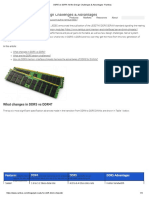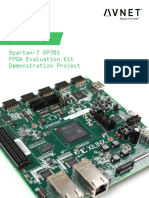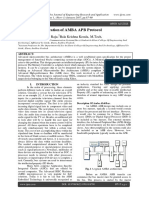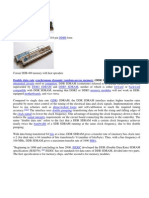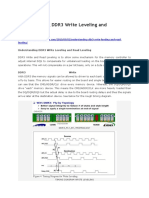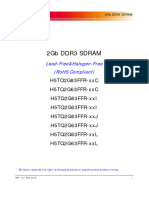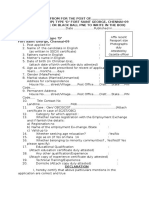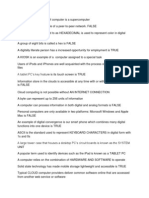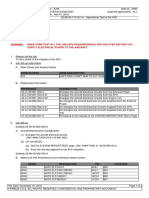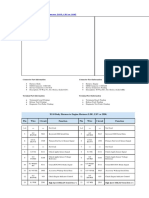Jishnu Rajeev
History Comparison DDR3 Improvements
Signaling Power Pin Out ODT Fly By Topology READ/WRITE Leveling
Power Up Routing Guidelines
DDR RAM was first introduced to allow data transfers on each edge of the memory clock DDR technology has been developed because the actual DRAM chips cant keep up with the data rates required by modern processors
The DDR memory modules
have a 64-bit interface so data is transferred at 64 times the transfer rate
DDR3 is a member of the SDRAM family of technologies (DDR/ DDR2/ DDR3) DDR3 SDRAM - doubledata-rate three synchronous dynamic random access memory DDR3 is a RAM interface technology used for high bandwidth
�Items Clock frequency
DDR3 SDRAM 400/533/667/800 MHz
DDR2 SDRAM 200/266/333/400 MHz
DDR SDRAM 100/133/166/200 MHz
Transfer data rate
I/O width Prefetch bit width Clock input Burst length Data strobe Supply voltage Interface CAS latency (CL) On die termination (ODT) Component package
800/1066/1333/1600 Mbps
x4/x8/x16 8-bit Differential clock 8, 4 (Burst chop) Differential data strobe 1.5V SSTL_15 5, 6, 7, 8, 9, 10 clock
400/533/667/800 Mbps
x4/x8/x16 4-bit Differential clock 4, 8 Differential data strobe 1.8V SSTL_18 3, 4, 5 clock
200/266/333/400 Mbps
x4/x8/x16/x32 2-bit Differential clock 2, 4, 8 Single data strobe 2.5V SSTL_2 2, 2.5, 3 clock
Supported FBGA
Supported FBGA
Unsupported TSOP(II) / FBGA / LQFP
Lower signaling standard Reduced power x8 Prefetch Dynamic ODT for improved Write signaling Fly-by architecture Read/Write Leveling Driver calibration Device Reset DIMM address mirroring Improved device pin out
The following classes are defined by standard JESD8-6 from JEDEC:
Class Class Class Class I (un-terminated/symmetrically parallel terminated) II (series terminated) III (asymmetrically parallel terminated) IV (asymmetrically double parallel terminated)
SSTL buses are less susceptible to
overshoot undershoot ringing effects
Supply voltage reduced from 1.8V to 1.5V
30% power reduction (Micron claim) 25% is JEDECs official claim (Compared to DDR2 at same frequency bin)
Lower I/O buffer power 34 ohm driver vs. 18 ohm driver at memory device Improved bandwidth per Watt
��On Die - Termination
Termination Off Die
Nominal ODT
ODT (NOM) is the base termination resistance for each applicable ball, it is enabled or disabled via MR1
Dynamic ODT
the termination strength of the DDR3 SDRAM can be changed without issuing an MRS command, essentially changing the ODT termination on the fly (RTT_NOM to RTT_WR during a a WRITE burst )
Synchronous ODT Mode
The DRAMs internal ODT signal is delayed a number of clock cycles defined by the AL relative to the external ODT signal. Thus ODTL on = CWL + AL - 2 and ODTL off = CWL + AL - 2.
Asynchronous ODT Mode
In asynchronous ODT mode, ODT controls RTT by analog time
Allows for controller to determine the time delay for data command to data output of each DRAM (byte lane)Enables controller to capture data for each byte lane
Write Leveling manages the DQS/DQ on write data Read Leveling manages the DQS/DQ on read data
First the memory controller puts the DDR3 memory devices into the read leveling mode by writing to the MR3
register MPR bit
Causes output of a stream of 0101with a regular memory read command(read training sequence) the memory controller will adjust the internal DQS delay mechanisms on the read data path to create a proper window of the best capture window for the DQ using DQS Once these internal compensations are created for each DQS, the values will be stored for future usage MR3 is set back to normal DDR3 operational mode.
Burst Length control (BC4/8 on the fly)
8-bit pre-fetch is standard for DDR3 memories Thus, burst length of 8 is default
DDR3s also support pseudo BL4using burst chip
Improved system stability
Eliminates unknown startup states
Known initialization and recovery state
Cold boot reset Warm boot reset Removes controller burden to ensure no illegal commands
2X the bandwidth of DDR2
Component per pin800 MT/s to 1600 MT/s Bus bandwidth6400 MT/s to 12,800 MT/s
More open banks for back to back access Hide turnaround time Hide tRP
8 banks vs. 4 banks
Improved power delivery
More power and ground balls
Improved signal quality
Better power & ground distribution And better signal referencing
Fully populated ball grid
Stronger reliability Improved pin placement
Less pin skew
Tighter timing leaving chip
Address inputs A[0:14]: Provide the row address for ACTIVATE commands, and the column address and auto precharge bit (A10) for READ/WRITE commands, to select one location out of the memory array in the respective bank. Bank address inputs BA[2:0] : define the bank to which an ACTIVATE, READ, WRITE, or PRECHARGE command is being applied. Clock CK ,CK# : are differential clock inputs. All control and address input signals are sampled on the crossing of the positive edge of CK and the negative edge of CK#. Clock enable: CKE enables (registered HIGH) and disables(registered LOW) internal circuitry and clocks on the DRAM
Chip select CS# : enables (registered LOW) and disables (registered HIGH) the command decoder. All commands are masked when CS# is registered HIGH Input data mask DM: is an input mask signal for write data. Command inputs RAS#, CAS#, and WE# : (along with CS#) define the command being entered and are referenced to VREFCA. Data strobe DQS, DQS#: Output with read data. Edge-aligned with read data. Input with write data. Center-aligned to write data
Introduction of an asynchronous RESET# pin
Prevent Illegal commands and/or unwanted states Cold reset Warm reset Known initialization Resets all state information No power-down required Destructive to data contents
ZQ Calibration Pin
The RZQ resistor is connected between the DDR3 memory and ground Value = 240 Ohm +/-1% Permits driver and ODT calibration over process, voltage, and temperatures
DDR3 memories have two power pins defined.
Same voltage level of 1.5V nominal Separate pins help reduce power supply noise/interruption VDD Core Power VDDQ IO Power Therefore, there will be 2 different cases: Case 1 two separate sources Case 2 Single voltage source for both rails
The following should be applied whether a single voltage source or a separate voltage sources are used:
Apply Power: RESET# - to be maintained below 0.2V X VDD (min 200us) and all other inputs may be undefined The voltage ramp time between 300mV to VDD min must be no greater than 200ms
VDD > VDDQ, VDD-VDDQ < 0.3V The voltage levels on all other pins should not exceed VDD/VDDQ or be below VSS/VSSQ
Impedance
All signal planes must be 50 , single-ended, 10%. All signal planes must be 100 , differential 10%. All unused via pads must be removed, because they cause unwanted capacitance.
Decoupling Parameter
Use 0.1 F in 0402 size to minimize inductance. Make VTT voltage decoupling close to the DDR3 SDRAM components and pull-up resistors. Connect decoupling caps between VTT and VDD using a 0.1 uF cap for every other VTT pin. Use a 0.1F cap and 0.01F cap for every VDDQ pin.
Power
Route GND,1.5 V and 0.75 V as planes. Route VCCIO for memories in a single split plane with at least a 20mil (0.020 inches, or 0.508 mm) gap of separation. Route VTT as islands or 250-mil (6.35-mm) power traces. Route oscillators and PLL power as islands or 100-mil (2.54-mm) power traces.
General Routing
Use 45 angles (not 90 corners). Disallow critical signals across split planes. Route over appropriate VCC and GND planes. Keep signal routing layers close to GND and power planes. Avoid routing memory signals closer than 0.025 inch (0.635 mm) to memory clocks.
Clock Routing
Route clocks on inner layers with outer-layer run lengths held to under 500 mils (12.7 mm).The maximum length of the first SDRAM to the last SDRAM must not be more than 5 inches (127 mm) or 0.69 tCK at 1.066 GHz Clocks should maintain a length-matching between clock pairs of 5 ps or approximately25 mils (0.635 mm). Differential clocks should maintain a length-matching between positive (p) and negative (n) signals of 2 ps or approximately 10 mils (0.254 mm), routed in parallel. Space between different pairs should be at least two times the trace width of the differential pair to minimize loss and maximize interconnect density.
Address and Command Routing
Route address and command signals in a daisy chain topology from the first SDRAM to the last SDRAM. The maximum length of the first SDRAM to the last SDRAM must not be more than 5 inches (127 mm) or 0.69 tCK at 1.066 GHz. Do not route differential clock (CK) and clock enable (CKE) signals close to address signals.
External Memory Routing Rules
Match in length all DQ, DQS, and DM signals within a given bytelane group with a maximum deviation of 10 ps or approximately 50 mils ( 1.27 mm). Ensure to route all DQ, DQS, and DM signals within a given byte-lane group on the same layer
Termination Rules
Use an external parallel termination of 40 Ohm to VTT at the end of the fly-by daisy chain topology on the addresses and commands. Keep the length of the traces to the termination to within 0.5 inch (14 mm). Use resistors with tolerances of 1 to 2%.
Expected to run at 1.2 V or less At clock speeds up to 4266 MT/s Up to 40% Energy Efficient . Discards dual and triple channel approaches in favor of point-topoint where each channel in the memory controller is connected to a single module The first DDR4 memory module was manufactured by Samsung and announced in January 2011.










